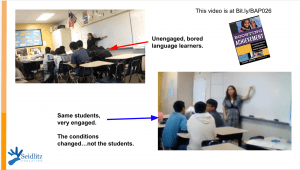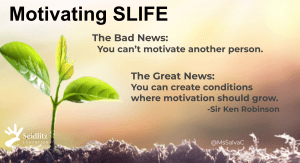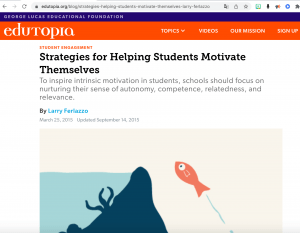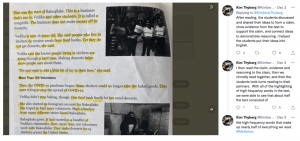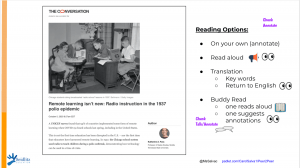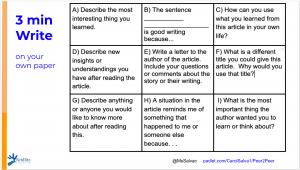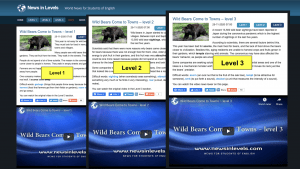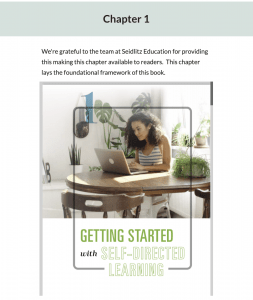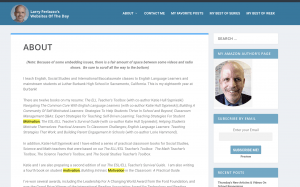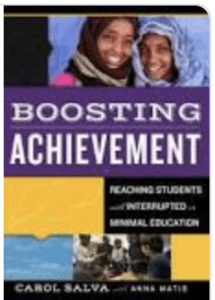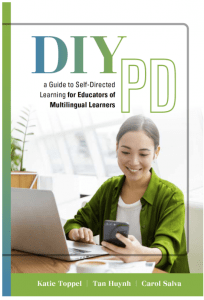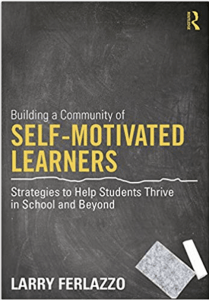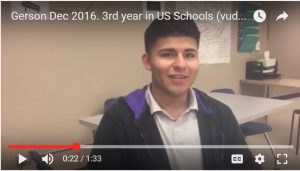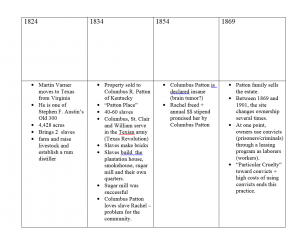Motivation is everything. If we don’t have engagement, what do we really have? We might have fake readers & students who are doing the bare minimum. But how would their learning change if they were engaged and intrinsically motivated to learn even when they are not with you?
I’m working around the US and Canada training, coaching, and modeling. I’m seeing some amazing things for new arrival students. This podcast is in response to feedback I’m getting from newcomer teachers I support. MANY are telling me:
“I’m struggling with engagement.”
Well, we have solutions! You listen to this show right here or in your favorite podcast app:
Listen to “BAP103 Motivation & Engagement for SLIFE” on Spreaker.
You may prefer to watch this show on YouTube or right here:
And you can always just read through the notes below.
In this episode, I am standing on the shoulders of Dr. Lora Beth Escalante, who wrote “Motivating ELLs,” Researchers like Daniel Pink, and also the work of Larry Ferlazzo who is a practitioner, blogger, and author of many books on the subject. In fact, I’m following 4 things recommended by Larry Ferlazzo in this article.
Larry has shared this in more than one article. Check out more of his articles, books, and posts here. In the podcast, I mention the good news and the bad news about motivation. The bad news is that we can’t MAKE students be motivated. The great news is, just as Sir Ken Robinson tells us, we can create conditions where things should grow.
And we know what we need in our “garden” for optimal motivation conditions.
According to Ferlazzo, these are the 4 things that help students become intrinsically motivated:
-
Relatedness
-
Relevancy
-
Competence
-
Autonomy
In the show, I talk about each of these things and how we can foster them for multilingual learners. While this applies to all students, I am always specifically speaking to the teacher of SLIFE (Students with Limited or Interrupted Formal Education). Here are some of the things I mentioned for each:
Relatedness
Relationships! Does my teacher respect me? Do the other students respect me? How do we get along? How do I feel as a person? Is my culture appreciated?
Here is a show on creating a social contract if you feel that your classroom needs a reboot on how we treat each other.

Also, don’t underestimate how volunteers can support a sense of relatedness. Don’t have volunteers, ask your principal or PTA to send out this video to the community:
Relevancy
Ask yourself if students understand WHY you’re asking them to do _______. Whatever you want them to do, do they see the relevance for them and their lives? As an example, I want students’ eyes to go across text when things are read aloud to them. I need to explain to them why that is. For example:
If I am reading aloud to emergent readers, I want them to track the print with their fingers when they are first gaining the language. I want them to understand that if they track the print with their eyes 👀, they will see high-frequency words over and over again. This will support their decoding skills in a powerful way. They need to understand that 1/2 of all print is high-frequency words and gaining them will impact their language and literacy development dramatically. They need to read WITH me. We can absolutely chunk the text and help them negotiate meaning and be analytical about the text. But as emergent readers, they need to track the print to get more high-frequency words. This is the WHY.

Here is another example of relevancy from Kim Thyberg on Twitter:
I love how Kim is teaching grade-level concepts (claims/evidence/reasoning) but also helping her students understand how quickly they can begin to decode text as they gain these high-frequency words.
Competence
If I have a sense of competence, it means that I feel myself getting better at this activity. Before we think our kids lack grit and give up too easily, let’s remember that these same students will fail over and over again at video games. Why? Perhaps because they’ve had a little win at that level. They feel that they can figure out the level.. that they can master it. They don’t have mastery YET, but they are improving.
We can also think about ourselves and something we are trying to learn to do. Perhaps you want to bake your grandmother’s cookie recipe. The first time t
hey don’t look very good but they taste pretty close. So you try again. You try again because the small successes in your attempts give you a sense of competence. You feel that you can master it because you had some small wins.
When we think of our students who are not engaged or motivated… let’s think back to the last time they had an academic win.
There are many ways to give SLIFE little wins. Examples include:
Showing them growth every time we speak to them. Using any book and asking them to identify words or sounds of letters and pointing out any growth. I tried to do this every time I had them in a small group.
QSSSA is also a great strategy that gives your entire class an opportunity to have a win. See Ep 26 for more on QSSSA.
Autonomy
Autonomy means choice. We have seen many teachers sharing choice boards lately and as you can imagine, this leads to more engagement from learners. All of us want some choice in what we do. So perhaps we offer choices in how they participate in a task. ie: with a buddy, on their own, with the teacher:
We can also offer choice in how they reflect on what they read:
But one of the most important places they need autonomy is in WHAT they read during free voluntary reading time. We only had a few minutes a day to read for pleasure. But I was always emphasizing that they needed to read on their own whenever they could. For this to happen, they need LOTS of things to choose from. If you chose to read something, because it is of interest to YOU, you’re less likely to fake read or abandon the text. Stephen Krashen tells us that free voluntary reading is key to language acquisition. And YES, our SLIFE can read… with support!
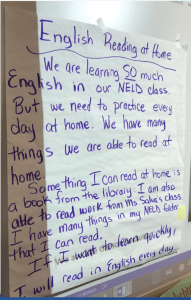 What can SLIFE, who have low to no literacy in their first language read? A lot!
What can SLIFE, who have low to no literacy in their first language read? A lot!
There are many things they can choose from. Examples include:
- Re-reading things we wrote in class together for fluency. Explain why this will boost their ability to decode text.
- A book they chose from the library or your classroom. We can show them how to negotiate meaning from any piece of text with technology (Google Images, Google Translate, Chrome Read Aloud Extensions)
- Ergo-Hi-Lo Ebooks These are high-interest, easy-to-read books that you can print or have e-versions.
- If you have the budget, get a library of Saddleback Hi-Lo readers! Saddleback books are my favorite Hi-Low readers if you have the budget for materials.
- A top tip is www.newsinlevels.com. I did a show about it here. That free website is so important once the students understand how to level up within the same article.
Two Examples of Highly Engaging Activities that Boost Literacy & Language Acquisition
🌟NEWS IN LEVELS🌟
News in Levels offers so much choice. This is not a little bit of choice… it is a TON of choice. It requires no login and they can choose from current or hundreds of prior articles. Here is how it relates to what we are talking about today:
- Relatedness: I will conference with new students and show them how to use it. I have faith in them that they can quickly learn the skills to make this meaningful. They can do it with a buddy or me or as a whole class for the first few times. I want to know their interests so I ask about what they are choosing to read about… RELATIONSHIPS & HOW WE REGARD THEM.
- Relevancy: The link I am giving you explains to you and to the students HOW to use it and WHY it works for older emergent readers. I even made a quick 5 min video to show students how to use the site. THIS OFFERS RELEVANCY for using this site and because they chose what they read about, and it is the actual news, it is by nature relevant to them.
- Competence: If they follow my advice, they will go through all three levels of an article before they move on to a different new story. They should be able to master level 1 with support (it is read aloud to them from YouTube, it includes images, they can use Google images & Google translate as well… they can even get support from others). When they go to level 2 & level 3 it is just about exposure to more complex language. They feel themselves getting better with word recognition the more they do of this. It offers an opportunity to level up, small wins, A SENSE OF COMPETENCE.
- Autonomy: As I mentioned above… this site offers a great deal of choice. The students need to have the autonomy to choose what they read and this site offers hundreds of articles.
CHOICE PROJECTS
I follow Noa Daniel and her Building Outside the Blocks philosophy has made a huge difference in my classroom.
- Relatedness: I model a choice project presentation. Students learn about me and get the message that I want to learn about them. All students learn about each other and throughout the year we are learning about each other and reinforcing appreciation for our diversity. Choice projects offer voice. RELATIONSHIPS
- Relevancy: Students choose what to present about. They are RELEVANT by nature.
- Competence: They practice, practice, practice what they will say. They read & re-read & re-read their scripts for their presentation and what they turn in. We can point out their progress in identifying and recognizing English words and sounds. This leads to a SENSE OF COMPETENCE.
- Autonomy: Students choose what they want to present about and they choose a day during the grading period that they want to present. There are many opportunities for autonomy.
Here is a video of a newcomer presenting her Personal Playlist project. More projects with resources can be found here also check out Noa’s site.
I hope this has been helpful. Shout out to all the teachers who are collaborating with me this year. I love all I learn with them!
Please take good care!
❤️, Carol
PS: Here are resources including a free chapter download for DIYpd4MLs book:
Other resources I used for this show:

